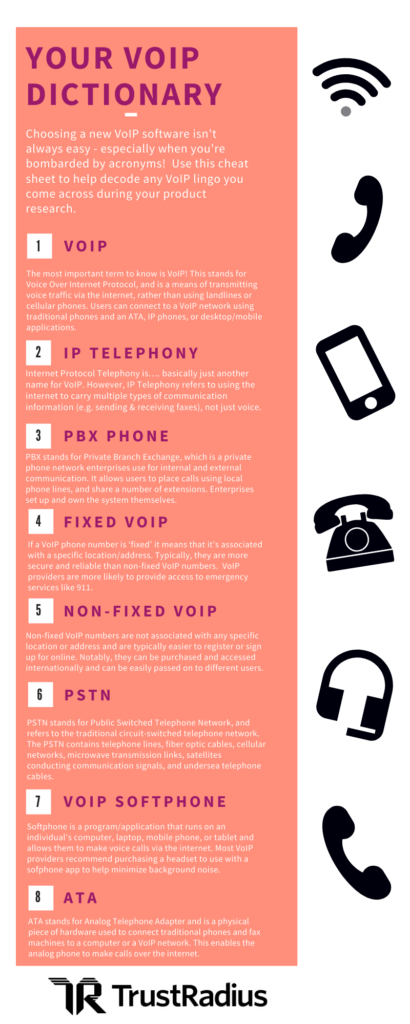VoIP Dictionary: Terms You Should Know
Nothing’s worse than getting all excited about buying a new gadget or another piece of tech, only to be met with a never-ending stream of confusing acronyms when you start researching your options!
In the world of B2B software buying, this is a frustratingly frequent reality. But don’t worry, we’ve done the preliminary research for you and come up with a list of 8 need-to-know VoIP terms.
Curious about what the difference is between fixed vs. non-fixed VoIP numbers, or when to use a PBX phone vs. VoIP Softphone? Check out the list below for a primer on all things VoIP, a little bit of IP telephony trivia (did you know that the PSTN has been around since the 1800s?!?), and some quick tip about which type of VoIP software is best suited for specific use cases.
8 VoIP Terms to Know Before You Start Researching
#1 VoIP
The most important term to know is VoIP! This stands for Voice Over Internet Protocol, and is a means of transmitting voice traffic via the internet, rather than using landlines or cellular phones. Businesses have multiple options when it comes to using and setting up VoIP technology. Users can connect to a VoIP network using traditional phones and an ATA (more on this later), IP phones, softphones, or mobile applications.
There is also a range of deployment options available; VoIP systems can be installed on-premise with phone hardware, or publicly or privately hosted in the cloud with mobile and desktop applications.
#2 IP Telephony
Internet Protocol Telephony is…. basically just another name for VoIP. However, IP Telephony refers to using the internet to carry multiple types of communication information, not just voice. This includes the sending and receiving of faxing. In contrast, ‘VoIP’ technically only refers to carrying voice traffic over the internet. But nowadays, many businesses and individual users employ these terms interchangeably and may use ‘IP Telephony’ to refer to any IP phones they have set up.
#3 PBX Phone
PBX stands for Private Branch Exchange, which is a private phone network enterprises use for internal and external communication. It allows users to place calls using local phone lines, and share several extensions. Rather than relying on telephone companies to provide the system, enterprises set up and own the system themselves. Phones connected to a PBX system can either use traditional physical phone lines (these are also called analog phones), or they can be connected via digital phone lines – aka VoIP lines.
#4 Fixed VoIP
If a VoIP phone number is ‘fixed’ it means that it’s associated with a specific location, such as a company or personal address, and are typically more secure and reliable than non-fixed VoIP numbers. Since fixed numbers are associated with a physical address, VoIP providers are more likely to provide access to emergency services like 911.
Fixed VoIP numbers cannot be purchased or accessed by individuals outside of the country, and are usually less likely to be used for making spam calls or fraudulent activity. This type of VoIP service works well for individuals that have an old phone number from a different phone service that they want to be associated with their VoIP account. For example, if you’re interested in replacing your landline with a VoIP phone line but want to retain your landline number, you can do this by subscribing to a fixed VoIP service.
#5 Non-Fixed VoIP
Non-fixed VoIP numbers are not associated with any specific location or address and are typically easier to register or sign up for online. They are also much more portable than fixed VoIP numbers, given that they aren’t tied to one address. Notably, they can be purchased and accessed internationally and can be easily passed on to different users.
Also sometimes called a ‘disposable VoIP number’, non-fixed VoIP services work well for individuals looking for an additional phone line, or who travel or move around frequently. Non-fixed numbers can be good for businesses looking for a way to facilitate online communication across multiple remote or international locations. One thing to be aware of is that non-fixed VoIP numbers can also be used for spam calling and fraudulent activity.
#6 PSTN
PSTN stands for Public Switched Telephone Network, and refers to the traditional circuit-switched telephone network. This is the system that traditional/analog phones are connected to. For example, landlines have traditionally been connected to the PSTN by an underground copper wire that hooks the landline up to a local exchange. VoIP services are often purchased as a substitute for traditional phones connected directly to the PSTN, or for mobile phones that rely on cellular networks to function.
The PSTN contains telephone lines, fiber optic cables, cellular networks, microwave transmission links, satellites conducting communication signals, and undersea telephone cables. These are all connected and regulated by switching centers. The PSTN has been around practically since telephones were invented and made available to the mass market sometime in the 1800s, which is why it’s sometimes also called the ‘POTN’ (Plain Old Telephony Network).
#7 VoIP Softphone
A ‘Softphone’ is a program/application that runs on an individual’s computer, laptop, mobile phone, or tablet and allows them to make voice calls via the internet. To make sure you’re getting the best audio quality while using the application, most VoIP providers recommend purchasing a headset that helps minimize background noise. As with all VoIP technology, a strong and secure internet connection will help ensure you get the best quality VoIP calls.
These programs are also called ‘desktop’ or ‘mobile’ VoIP apps. Some common examples of personal softphone VoIP apps include Skype, WhatsApp, and FaceTime. Vendors that provide cloud-based VoIP services for businesses provide a VoIP Softphone/desktop app, and many also offer VoIP mobile applications as well.
#8 ATA
ATA stands for Analog Telephone Adapter and is a physical piece of hardware used to connect traditional phones and fax machines to a computer or a VoIP network. This enables the analog phone to make calls over the internet. ATAs can connect phones to computers/networks using an ethernet cable, or connecting directly with another device using a USB cable. Long-distance voice calls using a VoIP service can often be cheaper than placing long-distance calls with a traditional phone that’s hooked up to the PSTN, or a mobile phone that relies on a cellular network.
Some vendors provide ATA equipment as part of their VoIP service package, you should check to see if the vendors you’re researching offer ATAs with their software package if you’ll be connecting traditional phones to the VoIP network.
Was this helpful?

